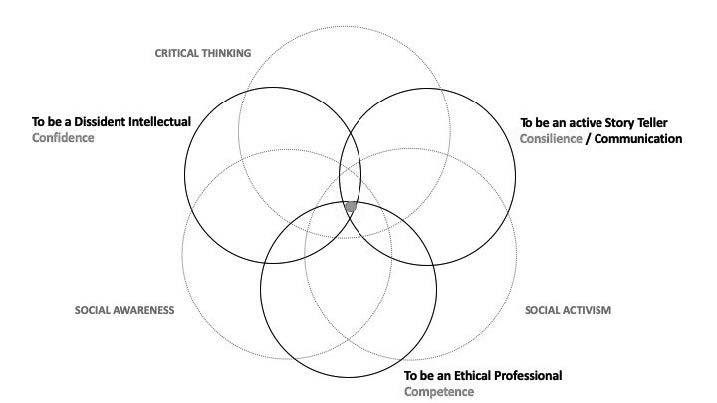A Reflection on Architectural Education Across the Nordic Baltic Academy of Architecture (NBAA). A Students’ Perspective
Downloads
DOI:
https://doi.org/10.51588/eaaeacp.71Keywords:
architectural education, NBAA network, citizenship, cosmopolitanAbstract
This paper presents findings from fourteen qualitative interviews conducted with students of architecture from eleven schools of the Nordic Baltic Academy of Architecture (NBAA). The interviews were analysed using the abbreviated Constructivist Grounded Theory (CGT) method. The findings reveal that students consider a meaningful architectural education one that helps them making ethical design choices. To do so respondents indicate that schools should help students find their inner compass, develop their professional skills, and ethical attitudes to think independently and make a difference in their society and beyond. Three narratives emerge which describe the multiple roles of an architect in our society: the dissident intellectual, the ethical professional, and the storyteller. On the basis of these findings and with the support of the work of Henry Giroux “Critical Theory and Rationality in Citizenship Education” and Martha Nussbaum “Patriotism and Cosmopolitanism”, a framework referred to as “Cosmopolitan Citizenship Architecture Education” is developed.
How to Cite
Published
Issue
Section
License
Copyright (c) 2020 Massimo Santanicchia

This work is licensed under a Creative Commons Attribution 4.0 International License.
References
Barclay, E. and Resnick, B. (2019, September 22). How big was the global climate strike? 4 million people, activists estimate. Retrieved from https://www.vox.com/energy-and-environment/2019/9/20/20876143/climate-strike-2019-september-20-crowd-estimate
bell hooks (2003). Teaching Community, A Pedagogy of Hope. London: Routledge.
Boyer, E. L. (1990). Scholarship Reconsidered: Priorities of the Professoriate. San Francisco: The Carnegie Foundation.
Charmaz, K. (2014). Constructing Grounded Theory. Thousand Oaks: Sage Publications.
Collier, J. (2006). “The Art of Moral Imagination: Ethics in the Practice of Architecture”, Journal of Business Ethics, Vol. 66, No. 2/3, the 11th Annual International Conference Promoting Business Ethics (Jun-Jul 2006): 307–31.
Deamer, P. ed. (2015). The Architect as Worker, Immaterial Labour, the Creative Class, and the Politics of Design. London: Bloomsbury Academic.
Froud, D. and Harriet Harriss eds. (2015). Radical Pedagogies Architectural Education and the British Tradition. London: Riba Publishing.
Freire, P. (1993). Pedagogy of the Oppressed. London: Penguin Books.
Galison, P. (1990). “Aufbau/Bauhaus: Logical Positivism and Architectural Modernism”. Critical Inquiry, Vol. 16, No. 4 (Summer, 1990), pp. 709–752. The University of Chicago Press. https://www.jstor.org/stable/1343765
Giroux, H. (2011). On Critical Pedagogy. London: Bloomsbury.
Giroux, H. (1980). “Critical Theory and Rationality in Citizenship Education”, Curriculum Inquiry, Vol. 10, No. 4 (Winter, 1980), pp. 329–366 Published by: Blackwell Publishing on behalf of the Ontario, Institute for Studies in Education/University of Toronto
Graham, J. (editor) (2017). And Now: Architecture Against a Developer Presidency. Essays on the Occasion of Trump’s Inauguration. New York: The Avery Review.
Guðjohnsen, R. Þ. (2016). Young People’s Ideas of What It means to be a Good Citizen. The Role of Empathy, Volunteering and Parental Styles (published doctoral dissertation). University of Iceland, Reykjavik, Iceland.
Harding, S. (2015). Objectivity & Diversity, Another Logic of Scientific Research. Chicago: The University Chicago Press.
Heller, S. and Veronique Vienne eds (2003). Citizen Designer: Perspectives on Design Responsibility, New York: Allworth Press.
Hooks, B. (1994). Teaching to Transgress. Education as the Practice of Freedom. New York: Routledge.
Keskeys, P. (2016). Patrik vs. Pritzker: Schumacher Reignites the Debate Over Political Correctness in Architecture. Retrieved from https://architizer.com/blog/inspiration/industry/patrik-vs-pritzker/
Lorentsen, E. & Torp, K.A. eds (2018). Formation, Architectural Education in a Nordic Perspective, Copenhagen: Nordic Baltic Academy of Architectural, Publisher B
Nussbaum, M. (1994). “Patriotism and Cosmopolitanism”. The Boston Review.
Ockman, Joan. (ed.). Architecture School, Three Centuries of Educating Architects in North America. London, The MIT Press, 2012.
Raworth, K. (2017). Doughnut Economics: Seven Ways to Think Like a 21st-Century Economist. Vermont: Chelsea Green Publishing.
Resnick, E. (2016). Developing Citizen Designers. New York: Bloomsbury Academic.
Santanicchia, M. (2018). “Systems Thinking and Systems Feeling in Architectural Education”. Chapter in the book Formation Architectural Education in a Nordic Perspective. Edited by Elise Lorentsen and Annabel Torp. Copenhagen: Nordic Baltic Academy of Architecture ISBN: 978–87–92700–23–0.
Santanicchia, M. (2019a). “Becoming Citizen Architects: A Case Study of ‘Streets of Reykjavik 2010’, a Design Studio at the Iceland University of the Arts”. Building Material 22: Public. ISBN: 978–0-902345–06–5.
Santanicchia, M. (2019b). “Citizenship in Design Education as a Transformative Learning Process”. Bogota: Cumulus.
Schumacher, P. (2017, March 31). The Miraculous Zaha Hadid: A Tribute by Patrik Schumacher. Retrieved from http://www.archdaily.com/868022/the-miraculous-zaha-hadid-a-tribute-by-patrik-schumacher.
Snodgrass, A and Richard Coyne (2006). Interpretation in Architecture. Design as a way of thinking. London: Routledge.
Strauss, A., and Corbin, J., (1990). Basics of qualitative research: Grounded Theory procedures and techniques. Newbury Park, CA: Sage.
Strauss, A., and Corbin, J. M., (1997). Grounded Theory in Practice. Sage Publications, Incorporated.
Tuhiwai Smith, L. (2012). Decolonizing Methodologies Research and Indigenous Peoples. London: Zed Books.
Weisman, L. (1994). Discrimination by Design: A Feminist Critique of the Man-made Environment. Urbana: University of Illinois Press.
Westfall, C. W. (2006). Why We need a Third Architectural Treatise, American Arts Quarterly, Summer 2006, Volume 23, Number 3. Retrieved from http://www.nccsc.net/essays/why-we-need-third-architectural-treatise.
Winston, A. (2016, 13 January). Architects “are never taught the right thing” says 2016 Pritzker laureate Alejandro Aravena, Retrieved from https://www.dezeen.com/2016/01/13/alejandro-aravena-interview-pritzker-prize-laureate-2016-social-incremental-housing-chilean-architect/





